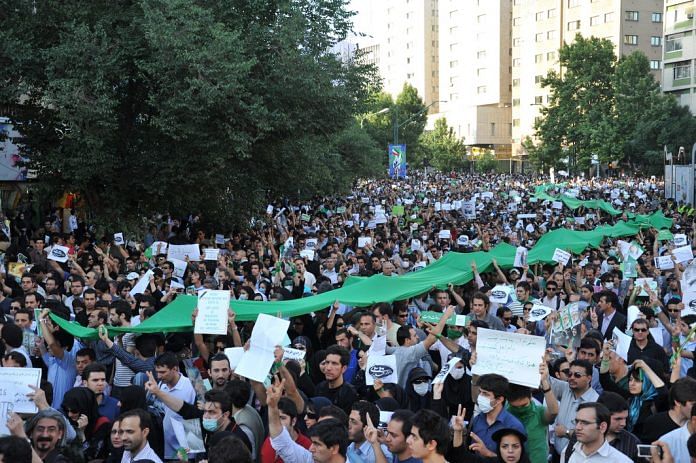The full extent of the protests that erupted across Iran over the weekend is hard to gauge, not least because the regime in Tehran has shut down internet access for most of the country. That decision suggests that the regime feels more threatened by the latest demonstrations of public anger than it did by previous protests at the end of 2017.
This round was sparked by the government’s decision to raise gasoline prices, to plug a budgetary hole caused in part by U.S. sanctions. But as we’ve seen recently in Lebanon and Iraq, the mood in the streets quickly morphed from complaints about gas prices to anger at general economic hardship — and then to an anger at the Islamic Republic’s system of government.
Despite the internet shutdown, videos circulated of protesters chanting slogans calling for the ouster of Supreme Leader Ali Khamenei. In some cities, they burned his posters — a brave thing to do in a theocracy that treats dissent with maximum cruelty.
Khamenei has had a bad few weeks: His name and image have been attacked in Baghdad and Beirut, as well as in his own country. He has backed the gas-price hike — with the careful caveat that he is not an expert in such matters. Characteristically, he has blamed “thugs” and foreigners for the protests and ordered a crackdown on Iranians voicing their unhappiness in the streets.
Also read: How activists are getting around the internet blackout in Iran
No surprise there: Khamenei fingered “enemies of Iran” for the 2017 protests; in reality, they were the result of rising food prices amid a general economic downturn. Then, too, he unleashed his security forces on the protesters.
President Hassan Rouhani, on the other hand, is unlikely to repeat the softer line he took on the 2017 protests, when he allowed that Iranians were right to protest. This time, since the demonstrations are the direct consequence of his decision, Rouhani is unlikely to be so charitable.
Will the protests continue despite the crackdown? Again, the internet blackout makes it hard to know. Iranians will have noted the stamina shown by Iraqis and Lebanese, who have kept up their demonstrations for weeks on end. But the Islamic Republic is much more brutal than Iraq or Lebanon, and Khamenei seems determined to prevent any repeat of the 2009 Green Movement, which rattled the regime.
The Trump administration will see the protests as proof that the sanctions campaign against Iran is working. Secretary of State Mike Pompeo professed solidarity with the protesters, tweeting, “The U.S. is with you.” This is unlikely to reassure any Iranians who recall President Trump’s promise in early 2018 that they would receive “great support” from the U.S. It is hard to argue with the regime’s assertion that such pronouncements are “hypocritical.”
But they needn’t be. The administration can do at least two things, and quickly, to demonstrate real support for Iranians — and intensify the discomfiture of Khamenei and Rouhani. The first is to remove Iran from the list of countries that Trump ill-advisedly slapped with a visa ban in 2017. The second is to clear away the sanctions-related uncertainties over the trade of essential and live-saving drugs to Iran.
Allowing Iranians to travel to the U.S. is self-evidently a good idea: The U.S. has a long, proud history of giving shelter to citizens from enemy nations. (It would not be hard to make sure that regime officials are denied access.) The resulting brain drain would weaken the Islamic Republic even as it gives the U.S. the moral high ground.
Life-saving drugs and medical equipment are, technically, exempt from U.S. sanctions. But confusion over what is and isn’t allowed and difficulty with processing payments have stymied Iranian importers. The Trump administration can easily solve these problems.
Doing both these things now, while the protests are raging, would make it harder for Iran’s leaders to deflect public anger by blaming the usual suspect. Small gestures, perhaps. But keeping Iran’s protesters focused on the true source of their torments can only be a good thing.
Also read: At least 106 killed in Iranian protests against fuel price hike, Amnesty says




I have always believed that sanctions – barring something that is surgically precise, meant to deny access to dual use technology, for example – end up hurting the most vulnerable sections of society, their access to food, medicines, basic necessities. To be used with utmost restraint, and only with UNSC authorisation. What is happening in Iran is cruel, indefensible.